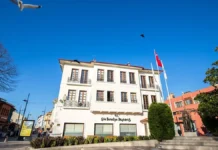Residents of the southeastern Turkish city of Diyarbakır’s historic Sur district cannot afford the new homes built following fighting between Turkish security forces and militants from the outlawed Kurdistan Workers’ Party (PKK), according to a report by IRIN, a news website focusing on humanitarian crises.
The fighting, which erupted following the failure of a peace process in July 2015 lasted until March 2016, forced Sur’s largely Kurdish residents to flee the district and resulted in large-scale destruction of property. More than 24,000 have still not been able to return to Sur, contributing to enmity between local Kurds and Turkey’s central government, according to IRIN’s report.
On the hunt for votes ahead of his June re-election, Turkish President Recep Tayyip Erdoğan visited Sur in March, promising to renovate the district as part of a TL 2,3-billion ($500 million) plan to revitalise the Southeast. He spoke of creating a vibrant economy and a new tourism boom.
However, government opponents believe Erdoğan’s administration plans to profit from the displacement and is engaging in demographic re-engineering. “The reconstruction is aimed at shaping the society through space, erasing the memory and creating a new memory,” said Nevin Soyukaya, an archaeologist with the SUR Platform, a group of citizens monitoring the reconstruction of Sur.
“Fighting was most intense in the central neighbourhoods of Sur district, a UNESCO World Heritage site in the provincial capital of Diyabakır, where ancient fortified walls surround historic mosques, churches, and synagogues. The ten months of conflict, including a three-month siege that damaged or destroyed the majority of buildings, has left many of those displaced by the violence feeling as if they must now fight for their homes and for their community and culture to live on,” said the report.
According to the report, Soyukaya personally helped place the district on the UNESCO World Heritage Site list in 2015, just months before conflict erupted. “Therefore, this is an attempt to change not only the physical structure, but also the demographic structure,” she said.
For Cengiz Abis, a Kurdish Sur resident whose family home was razed, not only is government compensation too low to allow him to buy back what will eventually be built in its place, but the area where he grew up still feels like a warzone.
“Diyarbakır has been invaded,” he says. “The whole city is filled with police stations, with armoured vehicles. When we look around, all we can understand is that we are under occupation. There are plain-clothed police everywhere. We are being followed and monitored all the time,” said Abis.
When the siege ended, security barricades closed off damaged areas and state officials ordered an “emergency expropriation” of about 60 percent of Sur properties. Large swathes of residential areas had been abandoned, and many houses collapsed under bombardment. These properties are now in the possession of the Ministry of Environment and Urban Planning.















